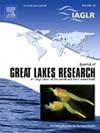Reducing bias in Coregonus artedi abundance estimates using stationary up-looking acoustics
IF 2.5
3区 环境科学与生态学
Q3 ENVIRONMENTAL SCIENCES
引用次数: 0
Abstract
Mobile hydroacoustic surveys using ship-based down-looking transducers are widely used to estimate densities for ecologically and economically important pelagic fishes. However, this method likely underestimates densities of some surface-oriented species due to biases associated with the acoustic surface exclusion zone and ship avoidance behaviours. We compared cisco (Coregonus artedi) density estimates from a stationary up-looking platform survey to a standard down-looking acoustic survey. Both systems were deployed during the fall cisco spawn in Thunder Bay, Lake Superior 2020–2022. Cisco density estimates from the stationary up-looking platform were on average 6.7 times higher in the upper water column (∼1–10 m) and 2 times higher over the entire water column (∼1–45 m) than those from standard mobile surveys. Ship avoidance behaviour associated with mobile surveys was apparent in the upper water column; median cisco densities observed by the platform fell from ∼36 to ∼9 fish/ha when the ship passed near the platform. Abundance estimates from the platform when not influenced by ship avoidance provided higher quota estimates than the standard survey in 2020 and 2022, but were similar in 2021. A multi-day deployment of the platform tracked a progressive daily increase in fish densities, highlighting the sensitivity of mobile survey results to the day they are conducted, often dictated by environmental conditions. Our results show promise in applying stationary acoustic deployments in fisheries surveys, with improved accuracy and reduced effort compared to mobile acoustic surveys in the management and monitoring of pelagic fishes in the Great Lakes.
减少偏差在Coregonus artedi丰度估计使用固定向上看声学
利用船载下视传感器的移动水声调查被广泛用于估计生态和经济上重要的远洋鱼类的密度。然而,由于与声表面隔离区和船舶回避行为相关的偏差,这种方法可能低估了一些面向表面的物种的密度。我们比较了固定向上平台调查和标准向下声学调查的cisco (Coregonus artedi)密度估计。这两个系统都在2020-2022年苏必利尔湖桑德湾的秋季思科产卵期间部署。固定向上平台的思科密度估计值在上层水柱(~ 1-10米)平均高出6.7倍,在整个水柱(~ 1-45米)平均高出2倍。与移动调查相关的船舶回避行为在上层水柱中很明显;当船只经过平台附近时,平台观察到的思科密度中值从~ 36条降至~ 9条/公顷。在不受船舶避让影响的情况下,该平台的丰度估计值在2020年和2022年提供的配额估计值高于标准调查,但在2021年相似。该平台的多天部署跟踪了鱼类密度的逐日增长,突出了移动调查结果对进行当天的敏感性,通常由环境条件决定。我们的研究结果显示了在渔业调查中应用固定声学部署的前景,与在管理和监测五大湖中上层鱼类的移动声学调查相比,它具有更高的准确性和更少的工作量。
本文章由计算机程序翻译,如有差异,请以英文原文为准。
求助全文
约1分钟内获得全文
求助全文
来源期刊

Journal of Great Lakes Research
生物-海洋与淡水生物学
CiteScore
5.10
自引率
13.60%
发文量
178
审稿时长
6 months
期刊介绍:
Published six times per year, the Journal of Great Lakes Research is multidisciplinary in its coverage, publishing manuscripts on a wide range of theoretical and applied topics in the natural science fields of biology, chemistry, physics, geology, as well as social sciences of the large lakes of the world and their watersheds. Large lakes generally are considered as those lakes which have a mean surface area of >500 km2 (see Herdendorf, C.E. 1982. Large lakes of the world. J. Great Lakes Res. 8:379-412, for examples), although smaller lakes may be considered, especially if they are very deep. We also welcome contributions on saline lakes and research on estuarine waters where the results have application to large lakes.
 求助内容:
求助内容: 应助结果提醒方式:
应助结果提醒方式:


